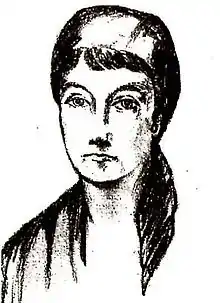Bidar Kadın
Bidar Kadın (Ottoman Turkish: بیدار قادین; 5 May 1855 – 13 December 1918) ; Bidar meaning Attentive in Persian was the fourth wife of Sultan Abdul Hamid II of the Ottoman Empire.[1]
| Bidar Kadın | |||||
|---|---|---|---|---|---|
 | |||||
| Tenure | Empress consort of the Ottoman Empire | ||||
| Born | 5 May 1855 Kobuleti, Georgia | ||||
| Died | 13 December 1918 (aged 63) Erenköy Mansion, Istanbul, Ottoman Empire | ||||
| Burial | Şehzade Ahmed Kemaleddin, Yahya Efendi Cemetery, Istanbul | ||||
| Spouse | |||||
| Issue | |||||
| |||||
| House | Talhosten (by birth) Ottoman (by marriage) | ||||
| Father | Prince Talhosten Ibrahim Bey | ||||
| Mother | Princess Şahika İffet Hanım Lortkipanidze | ||||
| Religion | Sunni Islam | ||||
Early life
Bidar Kadın was born on 5 May 1855 in Kobuleti, Georgia as a Georgian princess. Her original name is unknown. She was a member of the Kabardian princely family, House of Talhosten (Kabardian: Талъостэн). Her father was Talhosten Prince Ibrahim Bey and, her mother was Princess Şahika İffet Hanım Lortkipanidze, a Georgian. She had two younger brothers named Prince Hussein Pasha Talhosten and Prince Mehmed Ziya Pasha Talhosten (1860 – 1919), who were in service to Abdul Hamid.[2]
Marriage
Bidar married Abdul Hamid on 2 September 1875 in the Dolmabahçe Palace, when he was still a prince. Her name was changed according to the Ottoman court to Bidar , the Persian word meaning Attentive. [3] In late 1875, or early 1876, she became pregnant with the couple's first child. After Abdul Hamid's accession to the throne following the deposition of his elder brother Sultan Murad V, on 31 August 1876,[4] she was given the title of "Fourth Consort".[5][1]
Bidar who was pregnant at that time, gave birth to her first child, a daughter, four days later on 3 September 1876. The child was named Naime Sultan,[6] whom Abdul Hamid called "my Accession daughter."[7] In 1877, Bidar and other members of the imperial family settled in the Yıldız Palace,[8] after Abdul Hamid moved there on 7 April 1877.[9] Here she gave birth to her second child, a son, named Şehzade Mehmed Abdülkadir, on 16 January 1878.[10] In 1879, she was elevated to "Third Consort".[5]
Bidar was noted of not wanting Abdul Hamid to have relations with other women, and this made her constantly jealous of the others.[11]
On 30 September 1889, she met with the German Empress Augusta Victoria in the harem of the Yıldız Palace, when the latter visited Istanbul with her husband Emperor Wilhelm II.[12] In 1895,[5] she was elevated to "Second Consort".[1] In October 1898,[13] she again met Empress Augusta Victoria in the grand salon of the Imperial Lodge of the Yıldız Palace, when the latter visited Istanbul for a second time with her husband.[14]
On 27 April 1909, Abdul Hamid was deposed, and sent into exile in Thessaloniki.[15] Her brother Mehmed Ziya Pasha followed him. She, however, remained in Istanbul, and settled in a mansion in Erenköy.[16] After Thessaloniki fell to Greece in 1912, Abdul Hamid returned to Istanbul, and settled in the Beylerbeyi Palace, where he died in 1918.[17]
Death
Bidar Kadın died on 13 December 1918 at the age of sixty three, of a disease related to intestinal inflammation, ten months after the death of Sultan Abdul Hamid.[11] She was buried in the mausoleum of Şehzade Ahmed Kemaleddin, Yahya Efendi Cemetery, Istanbul.[1][18][19]
Issue
| Name | Birth | Death | Notes |
|---|---|---|---|
| Naime Sultan | 3 September 1876[20][6][21] | c. 1945[20][6][21] | married twice, and had issue, one son and one daughter |
| Şehzade Mehmed Abdülkadir | 16 January 1878[1][10][22] | 16 March 1944[10][22] | married five times, and had issue, four sons and two daughters |
In popular culture
- In the 2017 TV series Payitaht: Abdülhamid, Bidar Kadın is portrayed by Turkish actress Özlem Conker.[23]
References
- Uluçay 2011, p. 247.
- Açba 2007, p. 128, 129, 132.
- Açba 2007, p. 128.
- Clare, Israel Smith (1885). Illustrated Universal History: Being a Clear and Concise History of All Nations. P. W. Ziegler & Company. p. 549.
- Sakaoğlu 2008, p. 674.
- Brookes 2010, p. 285.
- Brookes 2010, p. 159.
- Oriental Gardens: An Illustrated History. Chronicle Books. 1992. pp. 21. ISBN 978-0-811-80132-4.
- NewSpot, Volumes 13-24. General Directorate of Press and Information. 1999.
- Brookes 2010, p. 277.
- Bağce, Betül Kübra (2008). II. Abdulhamid kızı Naime Sultan’in Hayati. pp. 16–17.
- Açba 2004, p. 27.
- Hidden, Alexander W. (1912). The Ottoman Dynasty: A History of the Sultans of Turkey from the Earliest Authentic Record to the Present Time, with Notes on the Manners and Customs of the People. N. W. Hidden. p. 417.
- Brookes 2010, p. 165, n. 9.
- Hall, Richard C. (October 9, 2014). War in the Balkans: An Encyclopedic History from the Fall of the Ottoman Empire to the Breakup of Yugoslavia. ABC-CLIO. pp. 1–2. ISBN 978-1-610-69031-7.
- Açba 2007, p. 128-9.
- Parry, Milman; Lord, Albert B. (1979). Serbocroation heroic songs, Volume 1. Harvard University Press. p. 371.
- Açba 2004, p. 53.
- Açba 2007, p. 129.
- Uluçay 2011, p. 254-55.
- Osmanoğlu 2000, p. 261.
- Osmanoğlu 2000, p. 261-62.
- Payitaht: Abdülhamid (TV Series 2017– ), retrieved 2018-09-30
Sources
- Açba, Leyla (2004). Bir Çerkes prensesinin harem hatıraları. L & M. ISBN 978-9-756-49131-7.
- Açba, Harun (2007). Kadın efendiler: 1839-1924. Profil. ISBN 978-9-759-96109-1.
- Brookes, Douglas Scott (2010). The Concubine, the Princess, and the Teacher: Voices from the Ottoman Harem. University of Texas Press. ISBN 978-0-292-78335-5.
- Osmanoğlu, Ayşe (2000). Babam Sultan Abdülhamid. Mona Kitap Yayinlari. ISBN 978-6-050-81202-2.
- Sakaoğlu, Necdet (2008). Bu mülkün kadın sultanları: Vâlide sultanlar, hâtunlar, hasekiler, kadınefendiler, sultanefendiler. Oğlak Yayıncılık. ISBN 978-9-753-29623-6.
- Uluçay, Mustafa Çağatay (2011). Padişahların kadınları ve kızları. Ankara: Ötüken. ISBN 978-9-754-37840-5.
_p259_Sultan_Abdul_Hamid_II.jpg.webp)
.svg.png.webp)